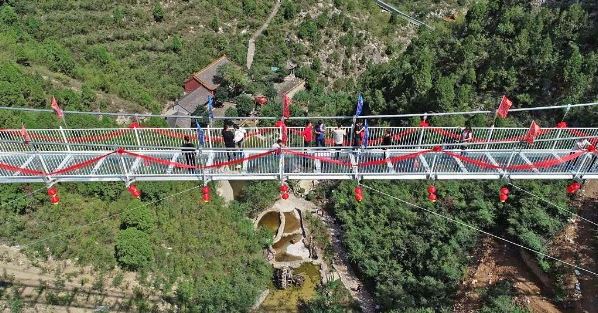
From the People's Daily app.
And this is Story in the Story.
Three years ago, more than 60 glass bridges were being built or had been completed in China.
In 2017, glass bridges had already become popular tourist attractions in Jiangxi, Hunan, and Yunnan Provinces.
In 2018, the world's longest glass circular bridge opened to the public in Central China's Henan Province. Because of its intimidating height, employees are stationed along the bridge to help the fainthearted make it across safely. While all visitors must cover their feet with "shoe gloves" to protect the surface.
In Hebei Province's East Taihang Scenic Area there is a glass bridge that looks and sounds like it might shatter when visitors walk on it.
However, the glass bridge phenomenon has raised a few eyebrows, and some have said the structures might be harmful to natural landscapes.
Today's Story in the Story looks at the emergence of glass bridges across China and how the structures have helped local economies.

(Photo: VCG)
Flying Dragon in the Sky, a glass bridge at Marenqifeng, a national-level attraction in Wuhu, East China's Anhui Province, was an immediate hit with visitors from all over China. Local tourism managers tout it as a sky-high advanced-tech glass bridge that "combines cultural elements and unique experience."
Smoke billows from both ends of the bridge from dragon heads made with fiber and reinforced plastic.
"The bridge also has light emitting diode displays on the surface, and when visitors step on the bridge, the equipment will show images and give out the sound of glass being shattered,” an employee said.
The 388-meter-long bridge hangs 180 meters above the ground, between two mountains.
A 488-meter-long glass suspension bridge opened to the public in Pingshan County in North China's Hebei Province. The glass-bottom bridge stands four meters wide and hangs between two cliffs around 218 meters above the ground.
"Walking on a transparent bridge is both exciting and nerve-racking," said Li Jinxiang, a resident of Hefei, the capital city of Anhui Province.
"You get nervous at every step you take," he said and added, "hearing the sounds of glass breaking and seeing the cracks on the display is a bit scary."
The fervor for glass bridges also led to viral videos made by visitors, with many of them crying, laughing, and lying down refusing to walk across.

(Photo: Xinhua)
Huaxi, one of China's wealthiest villages, built a glass bridge to develop its local tourism market.
Huaxi Party Chief Wu Xie'en said the village added the new feature to their tourism market while the town closed or upgraded traditional attractions.
Right now, a glass bridge that actually gives the illusion of being invisible by using mirrored stainless steel for its structure, and black stone, which becomes reflective when wet, for the flooring is under construction.
The structure will have two levels, one that doesn’t have a see-through floor for timid visitors, and a lower glass-floored walkway for thrill-seeking visitors.
Every seven minutes water will be sprayed onto the bridge to create a temporary cloud effect between the mountains.
At the Zhangjiajie National Forest Park, a transparent glass-bottomed bridge spans a canyon between two mountain cliffs.
When it opened in 2016, stretching 430 meters and with a height of 260 meters, it was the longest and tallest structure of its kind anywhere in the world.
Park officials had initially planned for 800 visitors at a time with a total of 8,000 daily.
It was reported that 80,000 people started arriving daily, forcing the park to close the attraction so upgrades could be made on parking, ticketing, and customer service assistance.
Four weeks later the bridge reopened to the public.
China's glass bridges have already become a proven favorite among Vietnamese travelers.
"Vietnam does not have glass bridges, so when I walked on Zhangjiajie Glass Bridge for the first time, it felt like I was walking on the Moon," said a Vietnamese visitor from Hanoi.
(Produced by Nancy Yan Xu, Lance Crayon, Brian Lowe and Da Hang. Music by: bensound.com. Text from Global Times and China Daily.)


